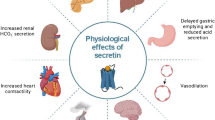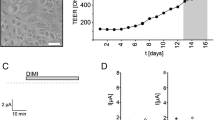Summary
Separate active transport mechanisms may account for the entry of bile salts and bilirubin into the biliary canaliculi from the hepatic parenchymal cells. Extracellular fluid follows in response to osmotic gradients and possibly also by an independent secretory mechanism. This “primary bile” probably is modified, as it passes down the bile ducts, by bidirectional movements of electrolytes across the epithelium. At least one active transport process involving bicarbonate is involved in a secretory mechanism in the distal ducts. The control of bile secretion involves three major factors: the presence of bile salts, gastrointestinal hormones, and vagal innervation. It is likely that the hepatic circulation may also influence bile secretion; presumably, the bile salt concentration of portal venous blood determines the secretion of bile salts by the parenchymal cells, but the details of the mechanism are missing. Gastrin, secretin, cholecystokinin-pancreozymin, and glucagon all increase bile flow, particularly by increasing the flow of sodium chloride and bicarbonate solutions. Therefore, the control of bile secretion can be divided into the secretion of bile salts and the secretion and reabsorption of water and electrolyte. The latter seems to be particularly subject to neurohumoral influences. Factors determining the secretion of bilirubin are less well understood but may include the effects of glucagon.
Similar content being viewed by others
References
Arias, I. M. “Formation of Bile Pigment.” InHandbook of Physiology (Vol. 5), Code, C. F., Ed. American Physiological Society, Washington, D. C., 1968, pp. 2347–2374.
Arias, I. M., Johnson, L., andWolfson, S. Biliary excretion of injected conjugated and unconjugated bilirubin by normal and Gunn rats.Amer J Physiol 200:1091, 1961.
Bergstrom, S., andDanielsson, H. “Formation and Metabolism of Bile Acids.” InHandbook of Physiology (Vol. 5), Code, C. F., Ed. American Physiological Society, Washington, D. C., 1968, pp. 2391–2408.
Brooks, F. P., Buchholz, R., andGould, B. Unpublished data.
Brooks, F. P., andGrossman, M. I. Symposium on Exocrine Glands. Univ. Pennsylvania Press. In press.
Brooks, F. P., Grossman, M. I., andVagne, A. Unpublished data.
Chenderovitch, J. Stop-flow analysis of bile secretion.Amer J Physiol 214:86, 1968.
Dowling, R. H., Mack, E., Picott, J., Berger, J., andSmall, D. M. Experimental model for the study of the enterohepatic circulation of bile in rhesus monkeys.J Lab Clin Med 72:169, 1968.
Forker, E. L., andHogben, C. A. M. Diodrast transit time in guinea pig biliary tree.Amer J Physiol 212:104, 1967.
Forker, E. L. Two sites of bile formation as determined by mannitol and erythritol clearance in the guinea pig.J Clin Invest 46:1189, 1967.
Forker, E. L., Hicklin, T., andSornson, H. The clearance of mannitol and erythritol in rat bile.Proc Soc Exp Biol Med 126:115, 1967.
Fritz, M. E., andBrooks, F. P. Control of bile flow in the cholecystectomized dog.Amer J Physiol 204:825, 1963.
Handbook of Physiology (Vol. 5), Code, C. F., Ed. American Physiological Society, Washington, D. C., 168, pp. 2347–2533.
Hanzon, V. Liver cell secretion under normal and pathologic conditions studied by fluorescence microscopy in living rats.Acta Physiol Scand 28 (Suppl. 101):1–268.
Ingelfinger, F. J. Digestive disease as a national problem: V. Gallstones.Gastroenterology 55:102, 1968.
Jones, R. S., andBrooks, F. P. Role of pyloric antrum in choleresis after insulin and feeding.Amer J Physiol 213:1406, 1967.
Jorpes, J. E. The isolation and chemistry of secretin and cholecystokinin.Gastroenterology 55:157, 1968.
London, C. D., Diamond, J. M., andBrooks, F. P. Electrical potential differences in the biliary tree.Biochim Biophys Acta 150:509, 1968.
Morris, T. Q., Sardi, G. F., andBradley, S. E. Character of glucagon induced choleresis.Fed Proc 26:174, 1967.
Nahrwold, D. L., Cooke, A. R., andGrossman, M. I. Choleresis induced by stimulation of the gastric antrum.Gastroenterology 52:18, 1967.
Neistadt, A., Lima, J. F. C., andSchwartz, S. I. Effects of portacaval shunts on flow and composition of bile.Surgery 61:427, 1967.
O'Maille, E. R. L., Richards, T. G., andShort, A. H. Acute taurine depletion and maximal rates of hepatic conjugation and secretion of cholic acid in the dog.J Physiol (London)180:67, 1965.
O'Maille, E. R. L., Richards, T. G., andShort, A. H. Factors determining the maximal rate of organic anion secretion by the liver and further evidence on the hepatic site of action of the hormone secretin.J Physiol (London)186:424, 1966.
O'Maille, E. R. L., Richards, T. G., andShort, A. H. Hepatic extraction of taurocholate and cholate in the dog.J Physiol (London)189:337, 1967.
Powell, K. C., Miller, L. E., andBrooks, F. P. Effect of sham feeding on bile flow in cholecystectomized dogs.Proc Soc Exp Biol Med 118:481, 1965.
Preisig, R., Cooper, H. L., andWheeler, H. O. The relationship between taurocholate secretion rate and bile production in the unanesthetized dog during cholinergic blockade and during secretin administration.J Clin Invest 41:1152, 1962.
Schanker, L. S. “Secretion of Organic Compounds in Bile.” InHandbook of Physiology (Vol. 5), Code, C. F., Ed. American Physiological Society, Washington, D. C., 1968, pp. 2433–2449.
Scratcherd, T. “Electrolyte Composition and Control of Biliary Secretion in the Cat and Rabbit.” InThe Biliary System, Taylor, W., Ed. Blackwell, Oxford, 1965, p. 515–530.
Sperber, I. “Biliary Secretion of Organic Anions and its Influence on Bile Flow.” InThe Biliary System, Taylor, W., Ed. Blackwell, Oxford, 1965, 457–467.
Vagne, M., Stening, G. F., Brooks, F. P., andGrossman, M. I. Synthetic secretin: Comparison with natural secretin for potency and spectrum of physiological actions.Gastroenterology 55:260, 1968.
Wheeler, H. O., Mancusi-Ungaro, P. L., andWhitlock, R. T. Bile salt transport in the dog.J Clin Invest 39:1039, 1960.
Wheeler, H. O., andRamos, O. L. Determinants of the flow and composition of bile in the unanesthetized dog during constant infusions of sodium taurocholate.J Clin Invest 39:161, 1960.
Wheeler, H. O., andMancusi-Ungaro, P. L. Role of bile ducts during secretin choleresis in dogs.Amer J Physiol 210:1153, 1966.
Wheeler, H. O., Ross, E. D., andBradley, S. E. Canalicular bile production in dogs.Amer J Physiol 214:866, 1968.
Wheeler, H. O. “Water and Electrolytes in Bile.” InHandbook of Physiology (Vol. 5), Code, C. F., Ed. American Physiological Society, Washington, D. C., 1968, pp. 2409–2431.
Zaterka, S., andGrossman, M. I. The effect of gastrin and histamine on the secretion of bile.Gastroenterology 50:500, 1966.
Author information
Authors and Affiliations
Rights and permissions
About this article
Cite this article
Brooks, F.P. The secretion of bile. Digest Dis Sci 14, 343–349 (1969). https://doi.org/10.1007/BF02235947
Issue Date:
DOI: https://doi.org/10.1007/BF02235947




